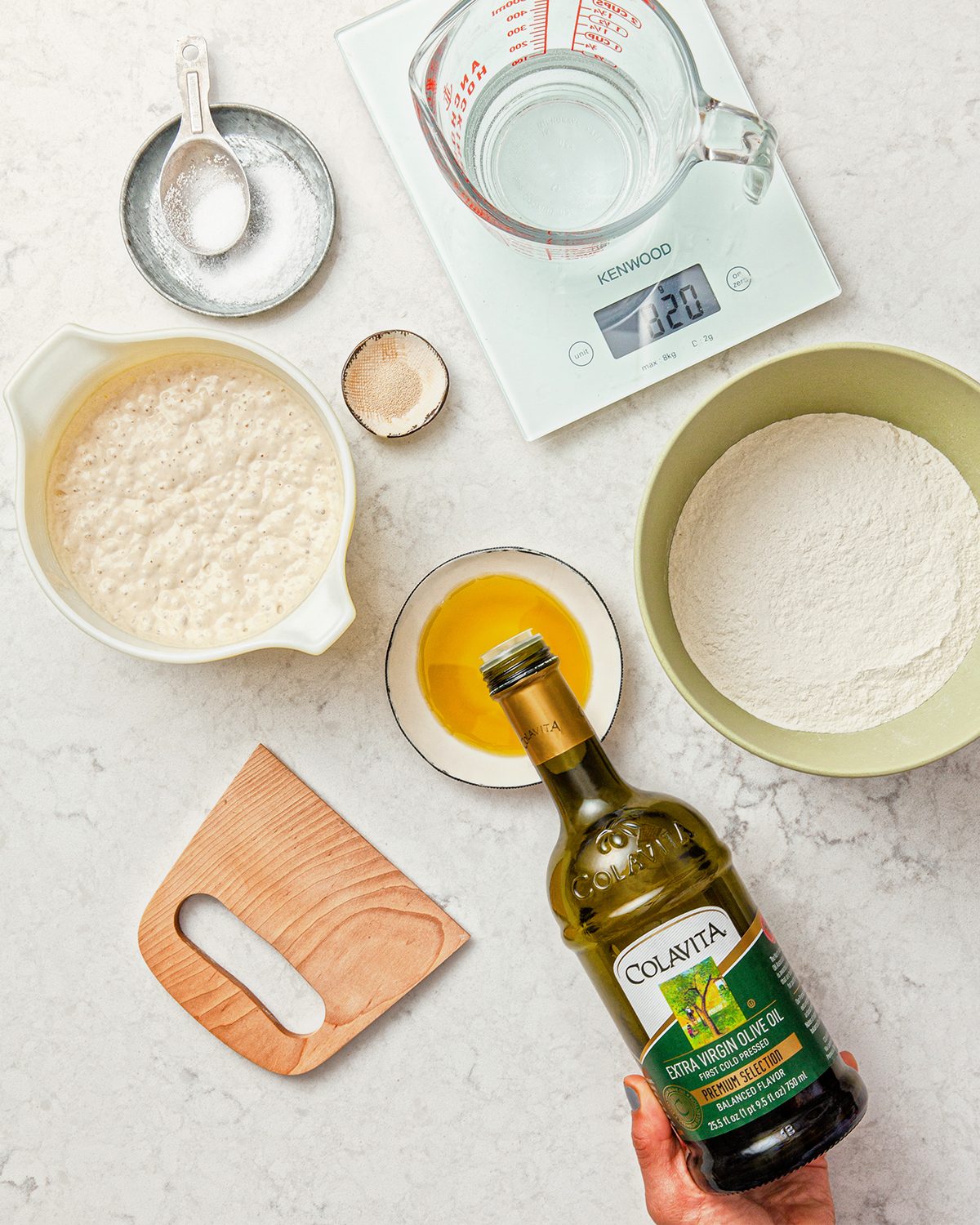Pizza Dough with Poolish

Sicilian Purple Potato Pizza
October 1, 2020
Detroit Pizza
October 1, 2020Pizza Dough with Poolish
This is a great way to get that sourdough-like flavor in your pizza dough without having to maintain a sourdough starter. All it takes is a little active dry yeast and some extra time.
Pair Recipe with:
Shaved Brussels Sprout and Pancetta Pizza
Cauliflower Pesto Pizza
Similar Colavita Recipes:
Pizza Dough with Sourdough Starter

Ingredients
Directions
In a quart sized plastic container or glass jar, mix together all the ingredients for the poolish until it is the consistency of pancake batter.
Loosely cover with a lid (you want to have some air flow in your mixture), and let it stand at room temperature for 12 hours, or overnight.
The next morning, your poolish should be lightly bubbling and smell yeasty.
Grab a large mixing bowl or the bowl of your stand mixer.
Add 340 grams of warm (80°F) water to the bowl.
Tare the kitchen scale, and add 200 grams of your poolish and the remaining ⅛ tsp of active dry yeast.
Mix it up so it disperses in the water.
Tare the scale again and add 600 grams of Type 00 flour to the bowl. If you DON’T have Type 00 flour, use all-purpose flour.
Mix it together with a plastic dough scraper. The dough will look shaggy.
Cover it with a kitchen towel and let it rest for 30-45 minutes. Note: This step is called the autolyse. It’s an important resting step that allows the gluten in the dough to activate and makes your dough strong. Don’t skip this step!
After that time is up, add the salt to the dough.
Mix with a dough hook on low speed for 8 minutes. You can also use your food processor to do this. You can even use your hands, but you’ll get a workout!
Turn the dough out onto a floured surface. Using a metal dough scraper, cut the dough into four pieces. Weigh them on a kitchen scale to make sure they’re all about the same weight—280 grams per piece.
Once you cut your pieces, it’s time to shape them. Roll them along the countertop, using the metal dough scraper to assist until they form into balls.
After they are shaped, place them on a rimmed baking sheet and cover them with plastic wrap.
Allow them to rise at room temperature until doubled in size (about 4 hours, but it may take more or less time depending on the temperature of room). You can also let them rise in the refrigerator for up to THREE days. That’s right, three days. This yields the best flavor.
The night before you want to make pizza dough, prepare your poolish.
There are so many ways you can mess around with the timing of dough rising by just adjusting temperature. Cold temperatures slow down the rising process, while heat speeds it up.
You can also add olive oil to this dough recipe, if desired. To do this, add 3 tbsp olive oil to the dough during the addition of salt at Step 11.
Shop this recipe
Ingredients
Directions
In a quart sized plastic container or glass jar, mix together all the ingredients for the poolish until it is the consistency of pancake batter.
Loosely cover with a lid (you want to have some air flow in your mixture), and let it stand at room temperature for 12 hours, or overnight.
The next morning, your poolish should be lightly bubbling and smell yeasty.
Grab a large mixing bowl or the bowl of your stand mixer.
Add 340 grams of warm (80°F) water to the bowl.
Tare the kitchen scale, and add 200 grams of your poolish and the remaining ⅛ tsp of active dry yeast.
Mix it up so it disperses in the water.
Tare the scale again and add 600 grams of Type 00 flour to the bowl. If you DON’T have Type 00 flour, use all-purpose flour.
Mix it together with a plastic dough scraper. The dough will look shaggy.
Cover it with a kitchen towel and let it rest for 30-45 minutes. Note: This step is called the autolyse. It’s an important resting step that allows the gluten in the dough to activate and makes your dough strong. Don’t skip this step!
After that time is up, add the salt to the dough.
Mix with a dough hook on low speed for 8 minutes. You can also use your food processor to do this. You can even use your hands, but you’ll get a workout!
Turn the dough out onto a floured surface. Using a metal dough scraper, cut the dough into four pieces. Weigh them on a kitchen scale to make sure they’re all about the same weight—280 grams per piece.
Once you cut your pieces, it’s time to shape them. Roll them along the countertop, using the metal dough scraper to assist until they form into balls.
After they are shaped, place them on a rimmed baking sheet and cover them with plastic wrap.
Allow them to rise at room temperature until doubled in size (about 4 hours, but it may take more or less time depending on the temperature of room). You can also let them rise in the refrigerator for up to THREE days. That’s right, three days. This yields the best flavor.
The night before you want to make pizza dough, prepare your poolish.
There are so many ways you can mess around with the timing of dough rising by just adjusting temperature. Cold temperatures slow down the rising process, while heat speeds it up.
You can also add olive oil to this dough recipe, if desired. To do this, add 3 tbsp olive oil to the dough during the addition of salt at Step 11.

